Europe's Largest Panorama Cinema in Moscow |
Read more at in70mm.com The 70mm Newsletter |
| Written by: Retyped from an old Danish trade magazine page about Mir's opening | Date: 30.11.2014 |
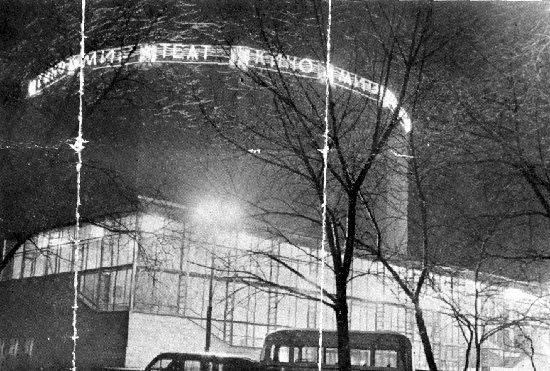 Mir's
illuminated facade Mir's
illuminated facade The largest panorama cinema "Mir" [Peace] in Europe opened in Moscow on the 28th of February 1958. The first audience for the first performance were all the craftsmen and architects who had participated in the construction of this mile stone cinema. All 1226 spectators took their seats in the circular cinema. They saw a documentary filmed by Roman Karmen. |
More in 70mm reading: in70mm.com's Kinopanorama page "Great is my Country" in Kinopanorama • Kinopanorama Films • Kinopanorama in Paris • Kinopanorama Update • Lost Orphaned Film • Soviet Circular Panorama • Sovscope 70 • "War and Peace" in 70mm • Foreign 70mm Films in Russia Internet link: New York Times review The Mir Theatre Silver Screens |
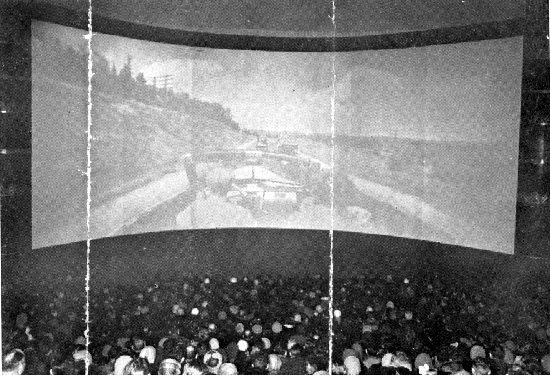 Mir's
gigantic screen, note the audience Mir's
gigantic screen, note the audienceThe screen, manufactured of white plastic, nearly covered 150 degrees of a circle. The screen measures 30 meters along the curve, and it is 12 meters high. 120 speakers are located behind the screen and in the auditorium. The image is composed of three projectors running in perfect synchronism, and the illusion is perfect. The audience sits in the middle and forget they are watching a film. The illusion of reality is perfect. |
04.12.2014 The Mir was launched in 1957 for test, buts for the public in February 28, 1958 and still alive as a live and movies venue. The screen size was 31 x 11,50 with a 90°curve. They were not 120 speakers. Only elementary elements. The were 5 for Panorama (12 element each) an one dedicated for optical sound (12 elements each) and a group af 6x4 speakers for the surround (2 elements in each). Its 120 elementary boomer an drivers, not enclosures. Olga and Lara are still alive. Lara went then to Perm Cristal Panorama as main technical Director. The Mir was adapted for 35/70mm an Panorama in the first years of the 60's and was a huge venue until the late 70's. It was mostly replaced by the Rossia, now in very bad shape. Regards Jean-Noël Grosmenil |
Russia's New 3-D Feature (Panoramic) Compares
Favorably to Cinerama
|
|
 Mir's
projection room, and Lara checking the lamphouse Mir's
projection room, and Lara checking the lamphouseFrom "New York VARIETY" on 12.03.1958 about the premiere of the first Russian Kinopanorama (Cinepanorama) film "Great is my Country" (How Broad is my Country / Vast is my Native Land / Shiroka Strana Moya Rodnaya) at the newly built Moscow Mir Theatre on 28.02.1958. Moscow, 11.03.1958 Russia`s first true 3-D, wide-curved screen film, via a process called Panoramic, is every bit as original, if not quite as exiting, as was "This is Cinerama", which opened in the U.S. a half dozen years ago. Entitled "How Broad is my Country", the 90-minute film is now playing in a Moscow theatre built especially for the curved screen process and called "Mir", which in Russia can mean either "World" or "Peace". |
|
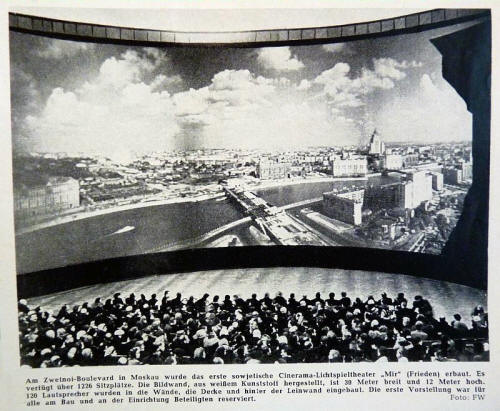 German
trade magazine about the opening of Mir, from Gerhard Witte's collection German
trade magazine about the opening of Mir, from Gerhard Witte's collection"How Broad is my Country" is a travelogue of sections of the Soviet Union including scenes of Moscow, Leningrad, Sochi on the Black Sea Coast, the Caucasus Mountains and the Carpathians. Judging from the lack of shrieks or even gasps, let alone women fainting as was the case in the roller-coaster ride in the first Cinerama film, "How Broad is my Country" lacks the excitement of its American counterpart. There are, however, many scenes that bear striking resemblance to the initial Cinerama film and its successors. There is a ride aboard a Soviet airline through valleys of the Caucasus Mountains, a landing on a cement airstrip, motorboat rides and a trip aboard a speeding electric train. Perhaps the best scenes in the film are in a steel furnace plant in the Ural city of Magnitogorsk and a fast-moving ride down a river of churning rapids aboard a log raft from a lumbering camp. |
|
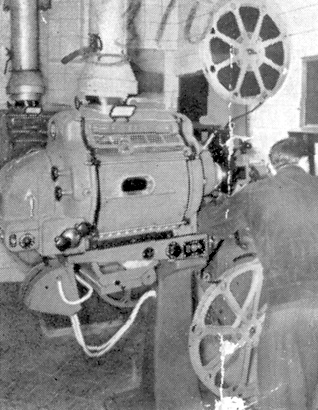 Mir's
projection room. Gregor checking the focus. Mir's
projection room. Gregor checking the focus.There were some particularly Soviet sequences. In showing the Winter Palace in Leningrad, now a State museum, the three segments of the screen suddenly switch from a single color picture to three panels of black and white. The center panel shows V.I. Lenin addressing a crowd. The side panels depict the Communist-inspired workers, peasants and soldiers storming the gates of the Winter Palace in 1917. Then, the film goes back to the business of travelogue. Whatever the inadequacies of the Panoramic film – including such deficiencies as general overexposure resulting in washed-out colors, uneven exposure among the three panels of the curved screen, and frequent visibility of the margins between panels – it does provide the best trip on film to date through the U.S.S.R. It may well be that in the exchange of films that is to follow the recently concluded cultural agreement between the U.S. and Russia, an exchange of a Cinerama film for this Panoramic film might provide an excellent beginning. The "Mir Theatre", seating 1,226 in a circular, paneled hall, is situated next door to the Moscow Circus arena. It is said by Soviet newspapers to be the biggest "Panoramic process theatre in Europe". The screen measures 101.7 feet (31 meters) wide by 37.7 feet (11.5 meters) high. There are 120 loudspeakers arranged all around the circular theatre. A second Panoramic picture is said to be in preparation which is to show Soviet science including footage on the Sputniks. |
|
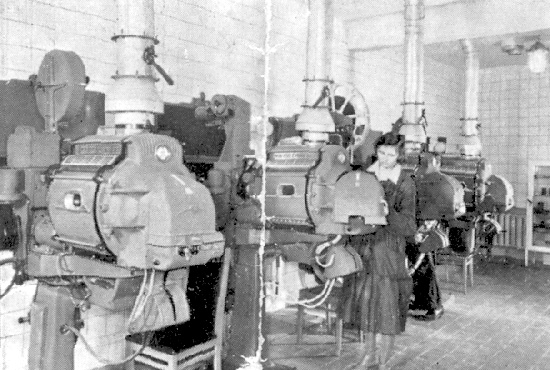 Mir's
projection room with 4 machines, and Olga checking the lamphouse Mir's
projection room with 4 machines, and Olga checking the lamphouseMore than the last half hour of the film is devoted to scenes of the Sixth World Youth Festival that took place in Moscow for 15 days during last July and August. Scenes show the parade by various youth delegations through Moscow's crowded streets to the huge Lenin stadium where an interminable parade of delegations, including one from the United States, took place. A dance on the grounds of the Kremlin during one Festival night also is depicted and the narrator intones: "Western bourgeois correspondents were invited. What will they find to write now about the mysteries of the Kremlin?" |
|
| Go: back - top - back issues - news index Updated 22-01-25 |
